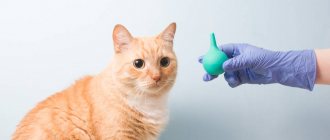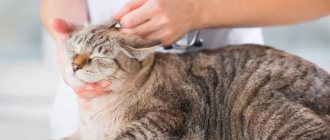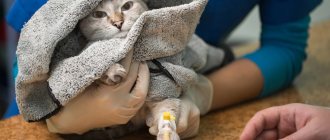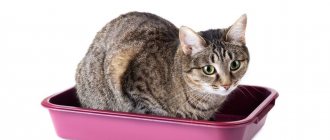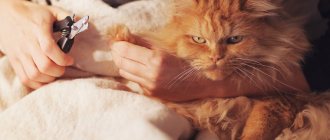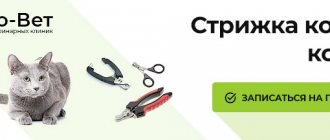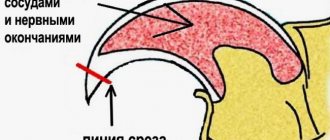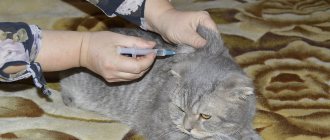Constipation can occur even in healthy, well-fed cats.
How to give a cat an enema at home is useful for every loving owner to know - especially if the breed is prone to problems with the gastrointestinal tract. The procedure as a whole is not difficult, so any cat owner can handle it.
The feasibility of enema
Typically, animals require assistance with forced bowel movements if they have not had stool for 3-4 days. This condition is called mild constipation. The reason for the lazy functioning of the digestive organs usually lies in an incorrect diet, namely a low fiber content. Another situation is the entry of foreign objects into the colon or illness.
Indications for use
An enema for a cat is prescribed strictly after examination by a veterinarian - self-medication can cause complications or even death. You cannot administer an enema to your pet on your own.
Main indications for performing an enema:
- chronic type of stagnation;
- poisoning of the body;
- inflammation of the gastrointestinal tract.
The first forced cleansing is best done in a veterinary hospital under the supervision of a specialist. In the future, you can give a cat an enema for constipation at home, but in compliance with all the doctor’s recommendations. He will tell you whether it is possible to give a cat an enema, and recommend a specific solution and volumes.
Permitted procedure frequency
Artificial bowel movement should be carried out as rarely as possible - so that the muscles of the organ do not lose tone, and in the future constipation does not become a constant problem. The maximum frequency is twice a week and provided that the cat cannot go to the toilet on its own.
Usually the veterinarian prescribes a one-time procedure and looks at the result. If it is not there, then the manipulation is repeated. If there is no stool after a double enema, the pet is given help of a different nature.
When not to do an enema
The issue of purification should not be decided on your own. A mandatory consultation with a veterinarian is required, who, after collecting all the tests and examining the patient, gives a prescription. Cleansing does not always help - on the contrary, there are situations when it is strictly contraindicated:
- pregnancy at any stage;
- injuries to internal organs or anus;
- obstruction;
- severe foci of inflammation in the colon;
- tumors/formations, malignant or benign;
- bleeding of various types;
- disorders of the cardiovascular system;
- bacterial or viral diseases.
As a rule, contraindications are violations hidden from the public eye. This is why it is highly recommended to visit a veterinarian before giving your cat an enema.
Reviews
Yaroslav, 28 years old, Kostroma:
“I had to give the cat an enema when they noticed that he had not defecated for more than 2 days. I still don’t understand the reasons, we give him good food. But immediately after the first dose of laxative, Microlax had a normal bowel movement, and so far there are no problems.”
Diana Viktorovna, 31 years old. Novosibirsk:
“Our cat apparently ate too much and couldn’t go out for a long time—4 days, to be exact. At the same time, he suffered - he huddled in the corner, crying pitifully. I gave him an enema according to all the rules, as the vet advised us. And he managed to go after about an hour. Now I will know what to do in such cases.”
Viktor Vasilievich, veterinarian, 48 years old, Odintsovo:
“If an animal has a small buildup of feces in the intestines, I advise my clients to do an enema themselves. Do not frighten the cat again and bring him to the treatment room.
A microenema will help stimulate the process of defecation, and everything will be fine with the animal. If microenemas do not help, then a deep cleansing of the intestines is needed. And then it’s better to see a doctor.”
Causes and symptoms of constipation
Some cats (especially certain breeds) are prone to digestive problems, and, accordingly, to difficulties with bowel movements. Veterinarians call normal bowel movements up to two times a day. The diagnosis of chronic constipation is made if visiting the toilet occurs once every 2-3 days. In this case, laxatives are prescribed, a diet high in fiber is recommended, and a forced bowel movement is performed. To prevent intoxication and dehydration, infusion therapeutic treatment (droppers and injections) is carried out.
The causes of intestinal congestion in cats are various diseases of internal organs (not only the digestive tract, but also the kidneys and liver), endocrine and even psychological disorders. Before treating constipation, you need to find out what caused it, otherwise the therapy will be ineffective and even harmful.
An attentive owner will easily identify the symptoms of a lazy bowel:
- Restless behavior while going to the toilet. The cat begins to make uncharacteristic sounds or meow loudly.
- Frequent, but ineffective sitting in the tray.
- Hard excrement with bloody or mucous discharge.
- Noticeable decrease in appetite.
- The apathetic mood of an animal that stops playing, licking itself, and tries to hide.
- Restless attitude towards caresses, touches in the abdominal area.
Constipation causes stool to accumulate and harden in the colon, making it difficult to empty it naturally. Prolonged absence of bowel movements can cause poisoning of the body due to rotting of food debris inside the intestine.
Contraindications
Enema - as a means of combating constipation is contraindicated in the following cases:
- tumors in the intestines;
- inflammatory process in the gastrointestinal tract;
- volvulus, acute obstruction;
- foreign body in the digestive tract (usually bone);
- pregnancy.
An enema is contraindicated for a cat if feces are excreted in small quantities and are black in color. This is a sign of internal bleeding in the upper digestive tract.
Types of enemas
There are two types of manipulation: medicinal and cleansing. The first involves the oral administration of medicinal formulations for local relief of symptoms. This form is prescribed only by a veterinarian to remove accumulated masses in areas of inflammation. A cleansing enema is used to remove accumulated fecal matter from the colon. The composition used begins to liquefy the seals, enhances peristalsis and removes excrement from the body.
Both types are carried out by specialists and amateurs using a gas outlet tube, which can be purchased at a veterinary hospital or at a regular pharmacy. The advantage of this device is the small diameter of the nozzle, which is well suited for pets. The cleaning composition is administered using a large-volume medical syringe.
You can use a Microlax enema with the addition of Vaseline. This mixture not only cleanses, but also promotes the healing of microcracks on the intestinal walls. Chamomile decoction also helps well, as it relieves pain, relieves inflammation and kills dangerous microorganisms.
The type of enema, as well as the substance administered, can only be recommended by a veterinarian - he will make a prescription after determining the cause of constipation, its severity and diagnosing the characteristics of the animal’s body.
What to do if it doesn't help?
If after the procedure there is no bowel movement after 2-3 hours, you can do the enema again and introduce the remaining contents of the tube. But you cannot use Microlax three times in a row. The owner must remember that cats are very sensitive to stress.
It happens that microenemas do not help. This happens when a sticky hairball gets stuck in the intestines. In such cases, you need to urgently take the animal to a veterinary hospital for examination. Intestinal obstruction can only be treated surgically.
How to give an enema to a cat: algorithm of actions
Before carrying out the cleansing, it is useful for the owner to know what is needed for an enema and in what order it occurs. It would be safer to ask a family member to help, because pets are very resistant to such procedures and show strong resistance when trying to escape. Holding the cat at this time is the main task of the assistant.
What you need to prepare
Before giving a cat an enema at home, you need to prepare all the equipment and materials so that they are at hand. They can be purchased at a regular pharmacy or veterinary clinic; some of them can be easily found at home. For the cleaning procedure you will need:
- A syringe in the shape of a rubber bulb. Choose an option with a rubberized tip that will not injure the anus. The size of the syringe depends entirely on the age of the animal and varies from 150 ml for a kitten to 300 ml for an adult.
- Bowl for diluting the solution. Ordinary water with the addition of a few drops of apple cider vinegar (can be replaced with lemon juice) and petroleum jelly is suitable as an infused liquid. Some doctors recommend adding a teaspoon of sea salt (for kittens - half a teaspoon). The liquid temperature should be 25-30 degrees.
- Additional equipment: Vaseline or baby cream for application to the tip of the syringe, disposable gloves, a water thermometer, a comfortable and spacious basin for bowel movements.
In addition to all of the above, the owner will need patience, absolute calm and a clear understanding of the algorithm of actions. If you start to get nervous, your pet will sense it and become worried too.
Technique
Before carrying out the procedure, assess the situation: even the most peace-loving phlegmatic cat will not react well to this method of treatment. It is necessary to secure the pet well so that it cannot harm itself or a person. Towels, soft fabric or straps will do; if there is a special collar, use that too.
The manipulation is carried out on an empty stomach. The syringe is filled with a medicinal solution and squeezed, expelling excess air. After this, the tip of the pear is dipped in Vaseline or baby cream.
Then the tip is inserted into the anus in a helical manner, directed longitudinally to the spine. Actions should be slow and very careful, without pushing. Maximum penetration is 2 cm for an adult, 1 cm for a kitten. Deeper penetration with a syringe can seriously injure the patient. To avoid mistakes, you can make a mark on the pear with a pen or pencil.
Having inserted the tip into the anus, you should gradually press on the rubber bulb so that the solution begins to flow into the colon. If you feel difficulty with the passage of water, you should immediately stop the manipulation. Further injection of excess fluid will cause injury or rupture of the rectum.
The next important stage will be the forced retention of the injected fluid in the cat’s body. You need to close the anus with your tail and press it tightly. Both the owner and the cat will have to be patient - it will take at least 10-15 minutes. Only then will the stagnant masses begin to soften, and then natural bowel movement will occur. Then you will need a comfortable wide basin, in which the animal is placed instead of a tray.
How to give an enema to a kitten? There are no fundamental differences in the procedure for adults and children. You just need to reduce the portion of liquid according to the age and weight of the kitten.
If you are carrying out the procedure for the first time and do not know how to give an enema to a cat with constipation at home, it is better to seek help from a person who already has similar experience. Perhaps you have friends or relatives who once enema their animal.
Solution for administration
For each individual use, a new special composition should be prepared. It is done immediately before the cleansing process. There are several types of simple and accessible solutions:
- Warm remedy with added salt, which is made from 20 grams of magnesia and 30 grams of table salt. The mixture of substances is diluted with 100 ml of water and then dissolved over low heat. The liquid is introduced slightly warm.
- Saline solution, which is made from 30 grams of ordinary salt and 1 liter of water. To enhance the effect, you can add another 10 grams of salt, but only with the permission of the veterinarian. The liquid should be introduced gradually, in portions of 50 ml.
- Soapy liquid, which is made from 1 liter of water and 1 tablespoon of baby soap, grated. Only baby and light laundry soaps do not have dangerous additives, dyes and have a neutral pH level, so they can be used for cats without harm to their health.
- Chamomile decoction. The bags or flowers are brewed with boiling water and infused for 30 minutes. Afterwards, the solution is filtered through cheesecloth so that the crumbs do not penetrate into the liquid. For 1 liter of water, take 1 tablespoon of chamomile powder - or one sachet. The decoction is administered warm, almost at room temperature.
- Glycerin composition. Add 1 tablespoon of glycerin to 1 liter of water, mix and pour into a syringe.
The veterinarian advises which option to choose. Each composition has contraindications that affect the condition of the pet. Before use, the liquid is heated or cooled to a comfortable temperature.
Microlax
When the causes of constipation are unclear, it is dangerous to infuse large volumes of fluid. If ordinary laxatives do not work, and you cannot get to a doctor in the near future, the Microlax medicinal enema will help out. Even newborn kittens are not harmed by this mild osmotic drug:
- sodium citrate releases bound water
- sodium lauryl sulfoacetate softens accumulated masses
- sorbitol enhances the effect of the main agents
- Glycerin facilitates bowel movements
Sold in pharmacies, the tube contains 5 ml of gel - the dose for an adult. Before giving a Microlax enema to a cat, the contents are squeezed into a spoon and drawn into a syringe without a needle for ease of dosing. A third is enough for one time, the effect will occur in 5-15 minutes. The procedure can be repeated no earlier than 12 hours later. The nose of the syringe is too short for an adult cat; it is lengthened with a piece of rubber tube from a dropper.
For a newborn kitten weighing less than 300 grams - 0.1 ml of gel, more than 300 g - 0.3 ml. It is convenient to measure such small doses with an insulin syringe with a removable needle. Leftovers are stored on the refrigerator door. The nose is wiped with an alcohol wipe each time before and after, and the gel is warmed to room temperature.
